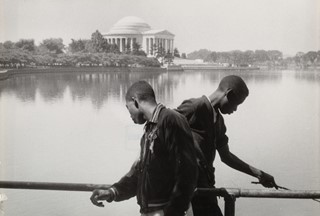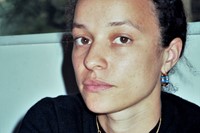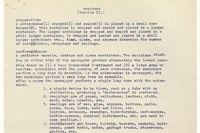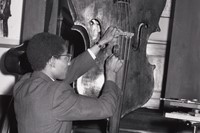The British designer gives us a tour of her second curatorial endeavour, Spirit Movers, a stirring exhibition of 50 objects hand-selected from MoMA’s vast archive
Grace Wales Bonner is synonymous with storytelling. Ever since her days as a student at Central Saint Martins, where she wrote a dissertation on “Black rhythmicality” in the work of artists Charlie Parker, Jean-Michel Basquiat and Kerry James Marshall, the lauded British fashion designer has centred her practice around assiduous archival research and the narrative potential of her chosen medium. Under her eponymous brand, Wales Bonner, she frequently collaborates with artists, writers and performers, too, interweaving different disciplines and genres to push the creative process even further. It’s no surprise then that art curation comes naturally to Wales Bonner, who made her curatorial debut at the Serpentine in 2019 with A Time For New Dreams, a show dedicated to “magical resonances within Black cultural and aesthetic practices”.
Last week, the designer unveiled her second exhibition, this time at MoMA, forming part of the New York institution’s ongoing Artist’s Choice series. As per the series’ premise, she was given free rein in the museum’s enormous collection to put together an exhibition on a theme of her choosing. The result is Spirit Movers, a captivating display of around 50 objects, each selected for its embodiment of the show’s titular concept, which, for Wales Bonner means the ability to “evoke multiple histories, inspire contemplation, and conjure new connections between people and places”. Among the works are pieces by Jean Dubuffet, Agnes Martin, Yasunao Tone, Hélio Oiticica and Richard Long, but the most prominent focus is on “Black cultural and aesthetic practices inspired by the styles, experiences, forms, and sounds of the African diaspora”.

Upon entering the tall-ceilinged exhibition space, the first impression is one of musicality: high on one wall, a round protruding sculpture, made from metal and drum skin by the American artist Terry Adkins, begs to be pummelled; below, a Marcel Duchamp assemblage – a cello fingerboard, with bushy horsehair strings – sits upright and absurd in a jutting display case; and on the back wall, another Adkins sculpture, Last Trumpet (1995), consisting of four towering horns placed bell-down, draws all eyes its way. “One of the things that’s always been fascinating to me is how sound can be captured through different forms,” Wales Bonner says of the initial idea behind the show, speaking to a small cluster of journalists at a preview ahead of the opening. “Adkins is an artist that’s really inspired me,” she continues gesturing to Last Trumpet, which, she explains, is one of the first pieces she selected for the show. “There’s something very sculptural about this work but it’s also something he used for performances.”
This was another point of interest for Wales Bonner when conceiving the show: “how objects and artworks can transform and become something new”. To demonstrate her point, next she guides us to a work by the African American Fluxus artist Benjamin Patterson, a blown-up photograph of whom, incidentally, greets visitors as they enter the space. Titled Overture (Version II), Overture (Version III), and Septet from “Lemons” (c. 1961), this piece comprises two framed sheets of paper bearing type-written instructions for a musical performance to be carried out communally, using an unconventional set of “instruments”. These include scissors and nails, Wales Bonner explains, materials that appear in other parts of the exhibition and which have what she terms “quite a sonorous quality”.
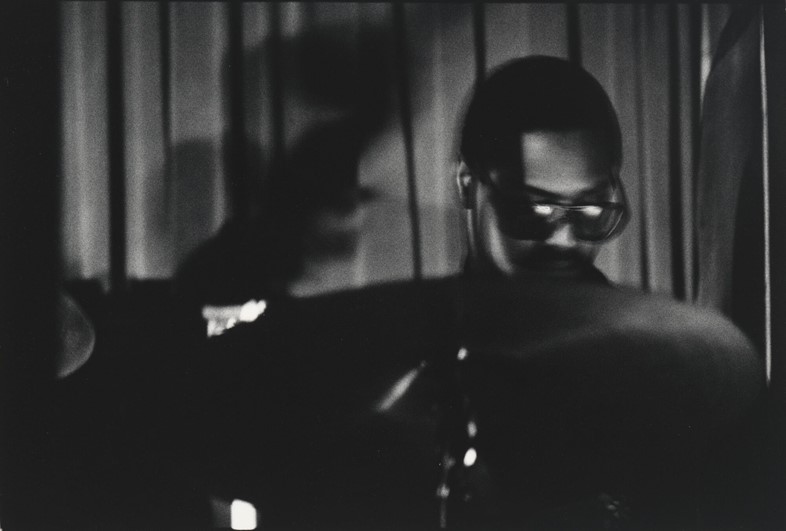
Materiality, unsurprisingly, was also one of the designer’s key criteria when choosing which works to include. “I was thinking about materials that have some kind of spiritual or magical tension,” she says, “and ones that hold evidence of the passing of time – the patina of the materials and the way that they’ve been transformed.” One such example is Lady With a Long Neck (1992), a striking sculpture by the late Senegalese artist Moustapha Dimé, an artist known for his evocative assemblages made from found materials. Here, a tree trunk bearing multiple cut marks – it was once a butcher’s chopping block, Wales Bonner explains – evokes a gangly figure, surrounded by a warped iron sheet resembling a billowing cape or dress. “It’s almost like it’s dancing.”
Gesture, and the presence of the artist’s hands, is another recurring theme, she notes: “this idea of movement and devotion, a rhythmic way of making that becomes embedded within an artwork. Whether that’s a painting that’s been created by repetitive strokes [she directs our gaze to an iridescent Agnes Martin painting, a grid of small rectangles painstakingly etched onto gold leaf; and a grey-blue pencil-and-oil-paint work by Korean artist Park Seo-Bo, its flurry of slanted staccato lines reminiscent of heavy rainfall] or the amalgamation of materials that have been placed together in a very specific, dedicated way.”

A quick chat with co-curator Michelle Kuo reveals that this description could just as well apply to Wales Bonner’s own meticulous design for the show. All elements were handcrafted in collaboration with dedicated specialists, Kuo says. The wooden pedestals bearing two Jean Arp sculptures, for instance, were made in Botswana from beautifully grained panga panga wood by Wales Bonner’s frequent collaborator, the designer Peter Mabeo, while brass shelves were hand polished to achieve an organic patina. Wales Bonner also envisaged the exhibit’s various wall niches and glass display cases – a rare sight at MoMA. A second look at these isolated sections reveals that many of them contain book-centric artworks. “I love reading and researching,” Wales Bonner tells me. “It’s always an entry point for me to understand my place in the world and to navigate to other places, so I liked the idea of them acting as a kind of portal here.”
Indeed, one of the show’s many strengths is how personal it feels to Wales Bonner and how seamlessly she can apply her ways of working and thinking to other disciplines, from the exhibition's scrupulous attention to craftsmanship and materials to the harmony – both physical and thematic – that exists between its various components. This applies to the overarching colour palette too: earthy tones, punctuated by blues and reds. “I was definitely exploring a sense of danger and darkness in my selection process, as well,” she says, in relation to the latter hue and some of the more spiky objects on show (like a book covered in pins, blades, and glass). “Because there’s also something quite disruptive about the idea of spirit. But the red’s also an important rhythmic device,” she adds. And the longer I stand in the space, reading the wall texts revealing the stories behind the works, letting my eyes be carried and my brain connect the dots, the more I realise just how many other connections abound, and what an intricately woven world Wales Bonner has once again managed to conjure.
Grace Wales Bonner – Spirit Movers is on show at MoMA in New York until 7 April 2024.
